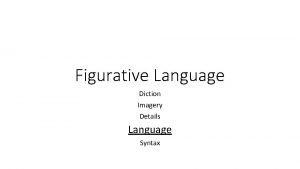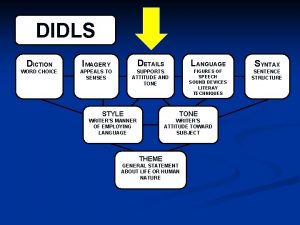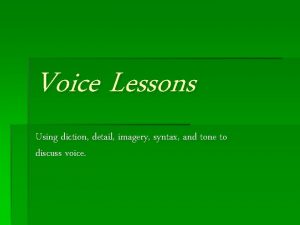VOICEDICTION DETAIL IMAGERY AND SYNTAX DICTION Diction is





- Slides: 5

VOICE-DICTION, DETAIL, IMAGERY, AND SYNTAX

DICTION • Diction is the author’s careful choice of words. • For example, the word “glob” in Walker’s work shows just how much disdain she had for her scarring, and it implies that she felt the world saw her as some kind of monster. • For example, the word “Indian” is striking in Alexie’s work since many consider the term a pejorative. It is interesting that the author chooses to embrace the term, though considering the negative tone of the work, it could be purposeful to reflect the negative experiences he had.

DETAIL • Detail is what makes writing come alive. It includes facts, observations, reasons, examples, and incidents. • For example, in Walker’s work, the detail of her “scalloped hem dress” and “biscuit-polished” shoes set up how much she cares about her appearance when she is younger, and the details about the “electric chair” and the “stone building, cold and drafty” signify the tone shift from vibrant and joyous to grim and melancholic. • For example, in Alexie’s work the details in his nicknames “Junior Falls Down” or “Steal-his-Lunch” demonstrate how often he was bullied and the breadth of ways in which he was bullied.

IMAGERY • Imagery is the use of words to re-create a sensory experience. This includes any experience with the five senses. • For example, in Walker’s work she reveals her loss of sight through a series of images, “feel an incredible blow” “brother lowers his gun” “”If you tell…” The audience can feel, see, and hear what she went though in that moment which is far more powerful than explicitly saying she was shot in the eye. • For example, in Alexie’s work he says that when his tribe look in the mirror they “see the history of our tribe in our eyes, taste failure in the tap water, and shake with old tears. ” These images highlight the deep rooted sadness and how even the mundane things like tap water pull up these sad roots. This sets up “everything looking like a noose. ”

SYNTAX • Syntax is the way words are arranged into sentences. This includes: sentence parts, word order, sentence length, and punctuation. • For example, in Walker’s work her choice to isolate key moments into single sentence paragraphs adds weight like, “It was great fun being cute. But then one day it ended. ” This accentuates theme and foreshadows the key event of her essay. It definitely adds drama. • For example, in Alexie’s work his choice to discuss basketball and doing drugs in parallel structure is purposeful: “all those possibilities and angles. It was mathematics, geometry. It was beautiful. ” vs “all those colors and noises. It was chemistry, biology. It was beautiful. ” First this aligns with the idea of Indian education since it seems as though Indians are often left to educate themselves; and when left to one’s own devices people tend to assign greater meaning to both good choices and bad.








